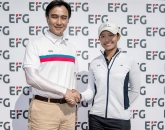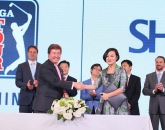
Sadly his problems did not end there. Adding pain to shame Hagen was admitted to a hospital in Calcutta ten days later with a life-threatening fever of 105.6 degrees after a bout of malaria. Losing most of his hair in the process, he made a complete recovery and was able to join Kirkwood on the next leg of their tour in Hong Kong after brief stopovers for matches in Rangoon, Penang, Singapore, Kuala Lumpur and Java.
Visibly exhausted neither man was in the right frame of mind when it came to an impromptu invitation to play golf in China on 14 April, 1938. Warned of the ongoing conflict between Japanese and Chinese forces in Shanghai, Hagen and Kirkwood questioned the wisdom of playing golf in a potential warzone but with a sizable cash deposit paid, they quickly changed their plans and headed for Hungjao Golf Club.
Golf was not unknown to Shanghai in the 1930s. A popular stop for European businessmen along with Shanghai Golf Club, Hongkew Golf Club and Kiang-wan Country Club, Hungjao had been extended from a nine-hole layout to a full eighteen back in 1923. Now the site of Shanghai Zoo, the club had been home to the richest members of Chinese society. Now it was home to an occupying force of 600 fully armed Japanese troops in what would be known as the second Sino-Japanese war.
The match was a strangely muted affair. Despite no formal truce being declared the game went ahead in relative silence broken only by the occasional round of enthusiastic applause from the Japanese, British and even Chinese dignitaries present.
After nine holes, tea was served by elegantly dressed Japanese women in kimonos who mixed freely with cheongsam-clad Chinese women. Plenty of photographs were taken and everything seemed remarkably cordial as the match ended in a respectable tie between Hagen and Kirkwood. The offer of a trick-shot show on down the first fairway was respectfully declined as the day drew to a seemingly successful conclusion. The official guests made their way to the exit and Hagen and Kirkwood waited in the clubhouse for a car to join them. It was then they received an unusual and slightly disturbing request from the Japanese Commander.
Pages
Click here to see the published article.











